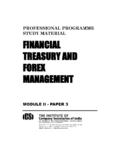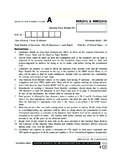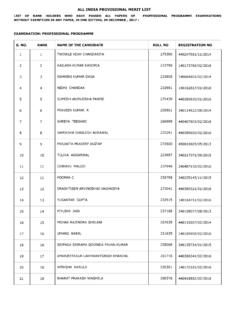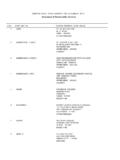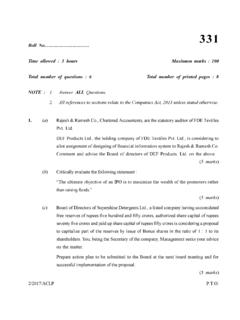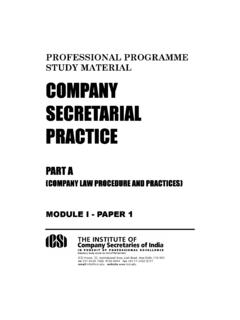Transcription of CONSTITUTION Introduction - ICSI
1 1 CONSTITUTION Introduction :- The Indian CONSTITUTION is unique in its content and spirit. The salient features of the CONSTITUTION are as follows:- Lengthiest written CONSTITUTION Blend of Rigidity and Flexibility Federal system with unitary features Parliamentary form of Government Independent judiciary Single citizenship Emergency provision Structure:- The Indian CONSTITUTION originally consisted of 395 Art, 22 parts, 8 Schedules. But after the CONSTITUTION 104th Amendment Act, 2003, the Indian CONSTITUTION Consists of 448 Art, 25 parts, 12 Schedules. Preamble:- The preamble to the CONSTITUTION is based on the objective resolution drafted and moved by Pandit Nehru and adopted by constituent assembly. It runs as follows:- We THE PEOPLE OF INDIA, having solemnly resolved to constitute India in to a SOVERIGN SOCIALIST SECULAR DEMOCRATIC REPUBLIC and to secure to all its citizen:- JUSTICE, social, Economic, and Political; LIBERTY of thought, expression, belief, faith and worship; EQUALITY of status and of opportunity;, FRATERNITY assuring the dignity of the individual and the unity and integrity of the nation; In our Constituent Assembly, this 26th November, 1949, do hereby adopt, enact and give to ourselves this CONSTITUTION .
2 Purpose of the Preamble:- The preamble to the CONSTITUTION is a key to open the minds of the makers and shows the general purpose for which they made the several provisions in the CONSTITUTION . Preamble serves the following purposes:- 1. It discloses the source of the CONSTITUTION . 2. It lays down the date of the commencement of the CONSTITUTION . 3. It set out the rights and freedoms which the people of India wished to secure for themselves. 4. It declares the nature of the government. Q1:- Whether Preamble is the part of the CONSTITUTION ? Ans.:- In the case of Kesvanand Bharti vs. State of Kerala, the supreme has held that preamble is part of the CONSTITUTION . Preamble is of extreme importance and the CONSTITUTION should be read and interpreted in the light of grand and noble vision expressed in the preamble.
3 However, two things should be noted:- The preamble is neither a source of power to legislature nor prohibition upon the powers of legislature. It is not justiciable not enforceable in courts of law. 2 Q2:- Whether preamble can be amended? Ans:- Supreme Court has held that preamble can be amended subject to the condition that no amendment is done to the Basic structure of the CONSTITUTION . The Preamble has been amended only once by the 42nd Constitutional Amendment act, which has added three new words- Socialistic, Secular and Integrity- to the preamble. Nature of Indian CONSTITUTION :-The CONSTITUTION is of two kinds:- 1. Unitary:- In a Unitary Constitutions the powers of the Government are centralized in one Government the States or Provinces are Subordinates to the Centre. 2. Federal:- In Federal CONSTITUTION , there is a division of Powers between the federal and the State Government and both are independent in their own spheres.
4 The American CONSTITUTION is universally regarded as an example of the Federal CONSTITUTION . Characteristics of a federal CONSTITUTION :- 1. A Written CONSTITUTION :- For a federal CONSTITUTION it is Mandatory that there should be a written CONSTITUTION . 2. Dual Government:- In case of federal CONSTITUTION , there is system of dual government one at centre and another at state. 3. Supremacy of Constitutions:- For a federal CONSTITUTION there should be supremacy of the CONSTITUTION . At the time of the exercise of power by three organs of the Govt. legislative, executive and Judiciary, all functions are Subordinated and Controlled by the CONSTITUTION . 4. Distribution of Powers:- Federalism means the distribution of powers of the State among a Number of Co-ordinate bodies each originating in and controlled by the CONSTITUTION 5.
5 Rigidity:- Rigidity is one of the Basic essential of a federal CONSTITUTION . It highly depends on the Process of amendment. 6. Independent Judiciary:- There should be an independent judiciary having authority on other organs. In a federal CONSTITUTION the courts (judiciary) has the final power to interpret the CONSTITUTION . Finally it should say that the judiciary is the Guardian of the CONSTITUTION . Conclusion : Finally if can be said that the Indian CONSTITUTION is neither Purely federal nor purely unitary but a Unique Combination of Both aspects. Peculiar feature of Indian CONSTITUTION :- Mode of formation Position of the state Citizenship Residuary power The lengthiest CONSTITUTION in the world. 3 Meaning of State:- ( ) The state includes:- The Government and parliament of India The Government and legislature of each of the states.
6 All local and other authorities: o Within the territory of India o Under the control of the Government of India All the fundamental rights are available against the state with a few exception. Some case law:- Electricity is a board within the meaning of Article 12. University Income- Tax department Corporation when deemed to be state?( Ajay hasia vs. Khalid Mujib) o If the entire share capital is held by government. o Financial assistance is provided by the government to meet the entire expenditure. o When corporation enjoys a monopoly status. o When the state is having deep and pervasive control over the affairs of the corporation. o If the corporation is discharging public function. Corporation acting as an agency instrumentality of the government. ( RD Shetty vs. IAA). Stock Exchange is not a state because it is independent from the government control.
7 (Satish nayak vs. Cochin Stock Exchange Ltd.) Fundamental Right Introduction :- The aim of Fundamental Rights is that certain elementary rights such as right to life, liberty, freedom of speech and freedom of faith and so on should be regarded as inviolable under all circumstances and that the shifting majority in legislatures of the country should not have a free hand in interfering with fundamental rights. Fundamental right is called the Magna Carta of India. Rights to Equality a. Equality before law-Art 14. b. Prohibition of discrimination on the grounds of religion race, caste, sex or place of Birth Art 15. c. Equality of opportunity in matters of public employment, Art 16. d. Abolition of untouchability Art 17 e. Abolition of titles, Art 18. Right to Equality Equality before Law:- says that the State shall not deny to any person equality before the law or the equal protection of the laws within the territory of India.
8 Analysis:- Art 14 uses two expressions:- (1) Equality before the law; and (2) Equal Protection of the laws (1) Equality before law This concept is taken from British CONSTITUTION . The concept of equality does not mean absolute equality among human beings which is physically no possible to achieve. It is a concept implying absence of any special privilege by reason of birth, Creed or the like in favour of any individual, and also the equal subject of all individuals and classes to the ordinary law of the land. 4 In the words of Equality before the law means that among equals the law should be equal and should be equally administered, that like should be treated alike. Rule of law The guarantee of equality before the law is an aspect of what Dicey Calls the rule of law in England. It means that no man is above the law and that every person, whatever be his rank or conditions, is subject to the jurisdiction of ordinary courts.
9 Dicey the Rule of Law has three distinct meaning (1) Supremacy of the law (2) Equality before the flaw (3) The CONSTITUTION is the result of the ordinary law of the land. (2) Equal Protection of the Laws This concept is taken from American CONSTITUTION . This has been interpreted to mean subjection to equal law, applying to all in the same circumstances. It only means that all persons similarly circumstance shall be treated alike both in the privileges conferred and liabilities imposed by the law equal law should be applied to all in the same situation and there should be no discrimination between one person and another. The words any person in Art 14 of the CONSTITUTION denotes that the guarantee of the equal protection of laws is available to any person which includes any company or association or body of individuals.
10 The protection of Art 14 extends to both citizens and non-citizens and to natural persons as well as legal persons. The equality before the law is guaranteed to all without regard to race, colour or nationality. Corporations being juristic persons are also entitled to the benefit of Art 14. Test of Reasonable classification While Art 14 forbids class legislation; it permits reasonable classification of persons, objects and transactions by the legislature for the purpose of achieving specific ends. But classification must not be arbitrary, artificial or evasive . It must always rest upon some real and substantial distinction bearing a just and reasonable relation to the object sought to be achieved by the legislature, classification to be reasonable must fulfill the following two conditions 1. the classification must be founded on an intelligible differentia which distinguishes persons or things that are grouped together from others left out of the group.
